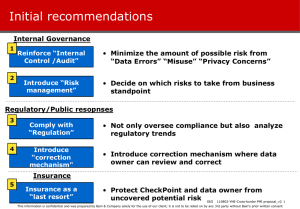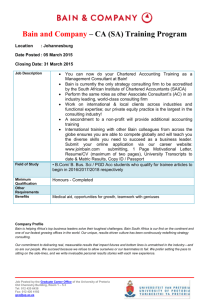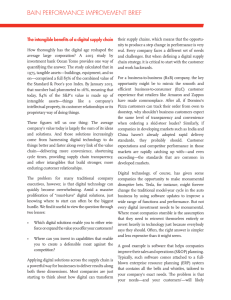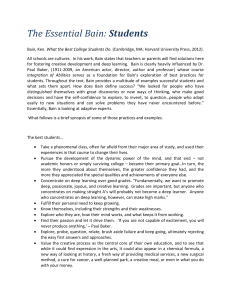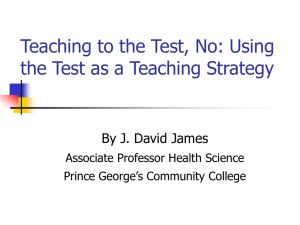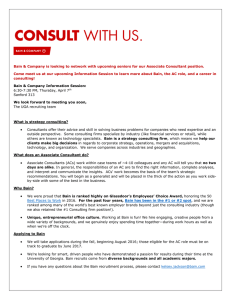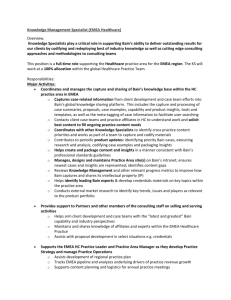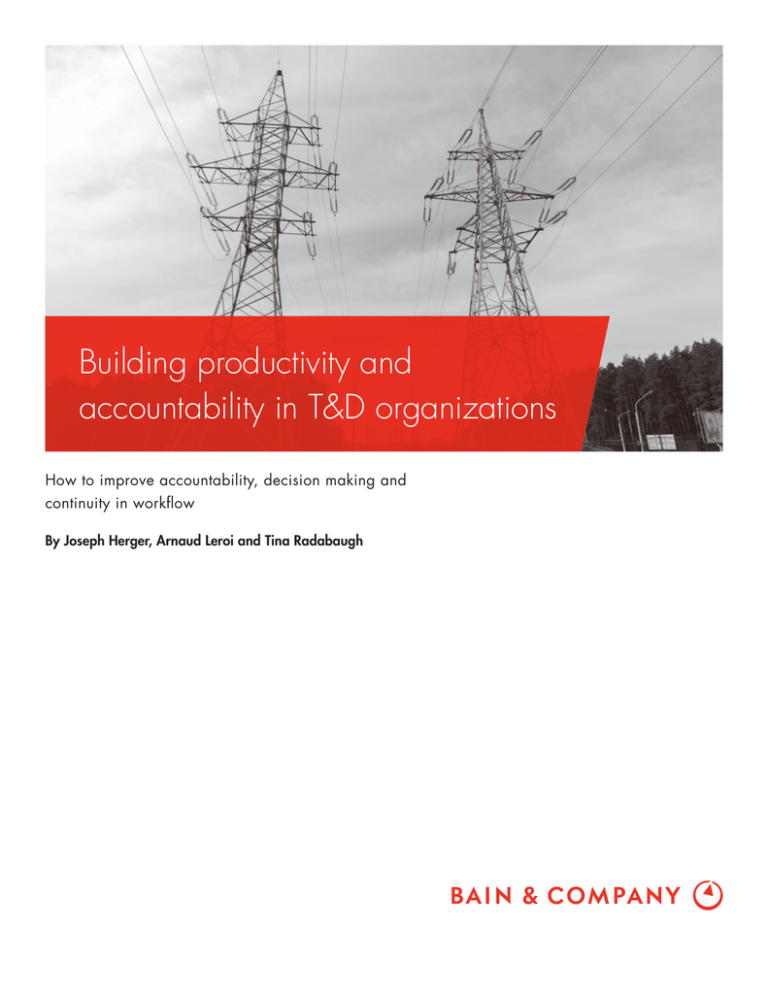
Building productivity and
accountability in T&D organizations
How to improve accountability, decision making and
continuity in workflow
By Joseph Herger, Arnaud Leroi and Tina Radabaugh
Joseph Herger is a principal with Bain & Company in San Francisco. Arnaud
Leroi is a partner in Bain’s Paris office, and Tina Radabaugh is a Bain partner
in Los Angeles. All three work with Bain’s Global Utilities practice.
Copyright © 2014 Bain & Company, Inc. All rights reserved.
Building productivity and accountability in T&D organizations
inspection, estimating, design, scheduling and work preparation shifted upstream to functional leaders who supervised these activities across all geographies. Utilities hoped
this centralization would deliver several benefits, including
reduced head count and workload balancing across regions,
higher service levels due to better specialization and expertise in functional areas, and improved performance from
standardizing processes and sharing best practices.
Utility transmission and distribution (T&D) organizations
manage dozens of complex, interdependent processes,
from job initiation through design, permitting, construction and job closure. Efficient execution requires close
collaboration across these processes, and effective management relies on clear controls and accountabilities
across the workflow.
Some T&D organizations have adopted centralized, functional organizational structures to improve efficiency and
reduce costs. But despite investments in centralization,
specialization, process redesign and technology systems,
many executives still feel that siloed, disconnected processes and unclear ownership prevent their operations
from achieving full potential.
The functional structures, however, imposed new problems. Local operators felt they were less able to be responsive to requests in their areas because they had to be
routed through centralized offices. Functions became
siloes with limited communication and collaboration
across planning, design and execution teams. Accountability became more elusive, and cost overruns or missed
deadlines led to finger pointing across functions. Transmission and distribution organizations created new
positions, such as expeditors, coordinators and crossfunctional program managers to address the gaps, but
that reduced the cost savings they had hoped for and
slowed processes down.
So how can T&D leaders create end-to-end process integration and ensure accountability across functions and wide
geographic areas? A common approach is to reorganize,
hoping that a different structure will produce better outcomes. But unless they address the underlying processes,
reorganizing merely trades one set of constraints for
another. A more certain way to boost efficiency and productivity is to focus on improving collaboration, accountability
and workflow among existing organizational groups.
Facing the operational challenges of a functional model,
some T&D executives now wonder if there is a structural
solution and whether they should return to a geographic
structure or organize by work type to unlock greater
efficiency and productivity (see Figure 1).
From geographic to functional models
Historically, utility transmission and distribution organizations often comprised many local operating units that
divided the territory by regions. Local superintendents
oversaw all aspects of maintenance and construction, from
inspection, estimating and design to construction and
order closure. This structure enabled quick decision making and took advantage of local expertise and relationships. It created clear lines of accountability, as local
leaders were responsible for performance in their areas.
These superintendents also integrated workflow and
made sure that work progressed smoothly from one step
to the next.
Our experience working with utilities suggests that,
while there may be an ideal structure for a T&D organization, based on territory size and diversity, level of
standardization and work mix, no structure offers a
silver bullet to the challenges of communication, collaboration and accountability (see Figure 2). Reorganizing may simply swap one set of challenges for another,
and unresolved problems tend to show up in new forms
after the reorganization.
Improve performance under any
organizational model
Over time, as larger utilities acquired smaller ones, cost
pressures increased and new technology systems touted
the efficiencies of centrally managed businesses, many utilities reorganized T&D operations by function. Local superintendents still controlled field crews, but responsibility for
Regardless of the organizational model, three critical
factors form the foundation for efficient and productive
T&D operations (see Figure 3). Focusing on these issues
rather than on the structural lines and boxes typically
1
Building productivity and accountability in T&D organizations
Figure 1: Three common T&D organizational models
Geographic
Local leaders oversee all functions
in their geographies
Functional
Work type
Central leaders oversee a single
function system-wide
Central leaders oversee all functions for
their work type (projects, maintenance,
new business)
• Consistency and consolidation of tasks
• Nonconstruction resources easily shared
across geographies
• Management focused on specialized
range of activities
• Greater dedication to types of work that
increases construction efficiency
• Fewer redundancies in local support
structure
• Simpler comparisons of annual performance
of groups
• Must have integrated processes to avoid
“throwing things over the wall”
• Disconnects between process steps are
difficult to diagnose and address
• Cross-functional issues often escalate to
the executive level
• Less flexibility if work mix changes across
years and places
• Unclear lines for dividing work
• Matrixed regional accountabilities for
reliability, governmental relations and
customers
Advantages:
• Clear ownership for performance
• Easier cross-functional handoffs
• Faster local decisions with more data
Challenges:
• Cross-region coordination required to share
resources
• Still requires central controls, resource
planning, strong middle management
• Can lead to nonstandardized processes
Source: Bain analysis
delivers greater gains in less time than embarking on a
large, transformational reorganization.
•
Integrated workflow. Establish essential connection
points and align priorities across organizational
groups to ensure the entire system works together.
•
Clear accountability. Focus on outcomes rather
than process steps, with metrics tied to activities
predominantly under the owner’s direct control.
•
Aligned decision rights. Empower those closest to
the work, but provide clear escalation and oversight
to make the best decision for the company.
Integrated workflow. T&D organizations are tightly
linked systems, with each department playing a critical
role in overall success. Any breakdowns between groups
and across functional, geographic or work-type boundaries
can hurt performance. Leading utilities use three tools to
ensure work flows smoothly across the organization.
2
•
Create visibility into work progress and develop
common expectations for lead times at each stage.
Participants in the workflow should have an integrated
view of the status of planned work, from initiation to
close. A dashboard showing metrics on work volume
and progression can ensure that teams across functions have common expectations for work delivery
dates and cycle times at each stage of the workflow.
Visibility and consensus on deadlines help the organization prioritize and address delays or bottlenecks
as they occur.
•
Identify and formalize critical handoffs. At one
utility, local maintenance schedulers often handed
small maintenance work to the capital projects
organization when they fell behind, leading to frequent disruptions and delays in the project work,
and reducing productivity. When the handoff process was formalized and put under central oversight, managers began to look more closely at the
costs and trade-offs of shifting small jobs. They put
Building productivity and accountability in T&D organizations
in a T&D organization where shared accountability and
integrated metrics are beneficial, as well as times
when these are the only realistic option. Three principles
help create strong accountability models.
in place new processes that reduced disruptions,
minimized redeployments and boosted the productivity of project crews.
•
Align resources with work plans. No one wants to
waste time and effort planning jobs that don’t get
built. One utility that had separate resource planning
activities for design and construction discovered that
these functional siloes were preventing communication about changes in funding and priorities from
reaching both groups at the same time. As a result,
9% of designed work was never constructed and a
similar amount waited more than 18 months to be
built. Bringing together the planning activity for all
operations ensured that resources were focused on
business priorities throughout the organization.
Clear accountability. A common principle of accountability models is to measure individuals on things that
they directly control; for most construction processes
this is challenging but feasible with the right analytics
and workflow definitions. However, there are levels
•
Create controllable outcomes for each group. The
steps in a T&D workflow can be divided into a few key
stages mapped to functional activities. With agreement on the necessary lead times at each stage—such
as how long before construction permits need to be
completed—each department can measure its performance more objectively. This also enables greater
accountability within functions, as resource planning,
design and construction teams can review their cycle
times and output. One utility reduced cycle times by
23% after improving visibility into stage gates and
interim due dates.
•
Accept some shared accountability. In some cases,
multiple groups will have to share responsibility for
outcomes. For example, utilities that organize by
work type are likely to have maintenance and con-
Figure 2: Organizational model should reflect structural and environmental factors
Management model
High centralization and control
• Automated decisions on schedules
and materials, made in advance
• Well-defined roles and handoffs
• Managed by detailed metrics
Inefficient execution, often with micromanagement
Centralized decision making, ownership and
process control (Functional model)
Local decision making and ownership of
outcomes (Geographic model)
Inability to capitalize on efficiencies and synergies
Low centralization and control
• Decisions made in real time,
based on judgments
• High work visibility for field crews
• Managed by fewer high-level
metrics
Less standardized and predictable
More standardized and predictable
• More work for new business and emergencies
• Heterogeneous network, many design standards
• Large region with variable geography, weather
and topography
• Limited, unreliable IT and ops systems
• Very little work for new business or emergencies
• Homogeneous network infrastructure, fewer
design standards
• Small, consistent geography and weather
• Robust, sophisticated IT and ops systems
Structural factors
More productive fit of structural
factors and management model
Source: Bain analysis
3
Less productive fit of structural
factors and management model
Building productivity and accountability in T&D organizations
Figure 3: Foundation for efficient, productive T&D
between local expertise and central oversight improves
productivity and efficiency. Leading utilities base their
decision-making infrastructure on a few principles.
operations under any organizational model
Aligned
de
cisio n ri g h t s
Clear
ac
c o u nt a b il i t y
• Leaders accountable for controllable
outcomes
• Shared accountability as necessary
• Built on a foundation of robust data
and reporting
• Empowered local
decision making
• Balanced with
central monitoring
and oversight
• Select points of
integration across
groups to optimize
the system
•
Empower those closest to the work to make decisions
based on their expertise. Over time, local managers
develop deep knowledge of their service territory,
from the terrain and the installed infrastructure to
the customers and local permitting and regulatory
bodies. They are well positioned to make decisions
that weigh local conditions and opportunities—
especially the scheduling and sequencing of work.
Local supervisors often unlock additional productivity and efficiency in a central plan.
•
Balance local decision rights with controls and monitoring at the center. While local expertise is valuable,
the functional center should still monitor things
like work progression, budget adherence, compliance
and customer commitments. Central monitoring
provides oversight for T&D leaders and helps local supervisors learn to make better decisions based on data.
•
Ensure decisions made by individual groups benefit
the entire system. Sometimes, the best decision for
a group isn’t what’s best for the whole organization.
At a utility organized by work type, the maintenance
and project groups both may have work in a remote
location. Neither group has the oversight to bundle
maintenance and project work together, even though
it would reduce travel time and increase productivity. Leading utilities identify these opportunities
and set up small teams with leaders from each group
who can work together to share data and make these
kinds of decisions.
Integrated
w o rk fl o w
• Visibility into progression
of work
• Common work prioritization
• Critical handoffs formalized
• Resources aligned with the
work plan across the entire
workflow
Source: Bain analysis
struction projects in the same territory. Each group
will affect overall reliability, customer satisfaction,
public safety and community relations. It can be difficult and even counterproductive to try to pin down
responsibility, especially if it pits teams against one
another. Sharing responsibility and accountability
can actually increase collaboration and convey a
sense that everyone is part of one team.
•
Invest in robust reporting. Agree on a single set of
data and one methodology for performance reporting. A centralized data warehouse and reporting
engine help to create a single version of the truth and
reduce effort spent on one-off variance justifications.
Creating agreement and confidence in the underlying information is critical.
As utilities continue to look for ways to improve affordability and reliability, increasing the efficiency of T&D
operations can deliver significant benefits on both fronts.
The path to unlocking these productivity gains lies in
improving the integration and coordination across organizational groups, rather than simply changing the structure of those groups. The processes described here can
improve any organization’s ability to smooth workflow,
ensure accountability and make better decisions.
Aligned decision rights. Managers of T&D organizations
must balance decision-making authority across geographies, functions and work types to optimize resources
for the whole system, rather than individual groups. When
making operational decisions, striking the right balance
4
Shared Ambit ion, True Results
Bain & Company is the management consulting firm that the world’s business leaders come
to when they want results.
Bain advises clients on strategy, operations, technology, organization, private equity and mergers and acquisitions.
We develop practical, customized insights that clients act on and transfer skills that make change stick. Founded
in 1973, Bain has 51 offices in 33 countries, and our deep expertise and client roster cross every industry and
economic sector. Our clients have outperformed the stock market 4 to 1.
What sets us apart
We believe a consulting firm should be more than an adviser. So we put ourselves in our clients’ shoes, selling
outcomes, not projects. We align our incentives with our clients’ by linking our fees to their results and collaborate
to unlock the full potential of their business. Our Results Delivery® process builds our clients’ capabilities, and
our True North values mean we do the right thing for our clients, people and communities—always.
Key contacts in Bain’s Global Utilities practice:
Americas:
Matt Abbott in Los Angeles (matt.abbott@bain.com)
Neil Cherry in San Francisco (neil.cherry@bain.com)
Paul Cichocki in Boston (paul.cichocki@bain.com)
Jason Glickman in San Francisco (jason.glickman@bain.com)
Mark Gottfredson in Dallas (mark.gottfredson@bain.com)
Joseph Herger in San Francisco (joe.herger@bain.com)
Stu Levy in Washington, DC (stu.levy@bain.com)
Alfredo Pinto in São Paulo (alfredo.pinto@bain.com)
Tina Radabaugh in Los Angeles (tina.radabaugh@bain.com)
Joseph Scalise in San Francisco (joseph.scalise@bain.com)
Bruce Stephenson in Chicago (bruce.stephenson@bain.com)
Jim Wininger in Atlanta (jim.wininger@bain.com)
Asia-Pacific:
Sharad Apte in Bangkok (sharad.apte@bain.com)
Miguel Simoes de Melo in Sydney (miguel.simoes-demelo@bain.com)
Amit Sinha in New Delhi (amit.sinha@bain.com)
Europe:
Julian Critchlow in London (julian.critchlow@bain.com)
Arnaud Leroi in Paris (arnaud.leroi@bain.com)
Jochem Moerkerken in Amsterdam (jochem.moerkerken@bain.com)
Jacek Poswiata in Warsaw (jacek.poswiata@bain.com)
Timo Pohjakallio in Helsinki (timo.pohjakallio@bain.com)
Kim Petrick in Dubai and Munich (kim.petrick@bain.com)
Roberto Prioreschi in Rome (roberto.prioreschi@bain.com)
José Ignacio Rios in Madrid (nacho.rios@bain.com)
For more information, visit www.bain.com

